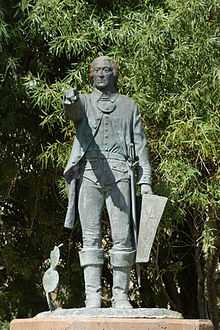Hugo Oconór
| Hugo O'Conor | |
|---|---|
 | |
| Hugh O'Conor | |
| 23ºGovernor of the Spanish Colony of Texas | |
| In office 1767–1770 | |
| Preceded by | Ángel de Martos y Navarrete |
| Succeeded by | Juan María Vicencio |
| Governor of Yucatan | |
| In office 1777–1779 | |
| Personal details | |
| Born | 1732 Ireland |
| Died | 1779 Yucatan |
| Military service | |
| Allegiance | |
| Service/branch | |
| Rank | Brigadier General |
Hugh O'Conor by birth or Hugo Oconór by Spanish, was a military governor of northern Mexico He was appointed governor of Texas by the Spanish viceroy of New Spain in 1767. It is recorded that O'Conor rode well over 10,000 miles on horseback in the course of conducting his duties. O'Conor was called "The Red Captain" by the Apache, both for the color of his hair and his formidable military leadership.
O'Conor is the founding father of the city of Tucson, Arizona having authorized the construction of a military fort in that location in 1775.[1] In 1777, O'Conor requested, due to his failing health, to be transferred to the Yucatan Peninsula, whereupon he was promoted to brigadier general and appointed Governor of Yucatan Peninsula. He served there until his death in 1779.
Biography
O'Connor was born in 1732 in Ireland, but raised in Spain.[2] He was a descendant of king of Ireland Turlough Mor O'Conor (dead in 1156), and for that reason the O'Conor family rejected British rule. For political and religious reasons, when he was 18 years old--like many other Irish aristocrats--O'Conor left his homeland and moved to Spain where his cousins Alexander and Dominic O'Reilly, were serving as officers in the Spanish Royal Army. He was established in Aragon.
In his youth he joined the regiment of Volunteers of Aragon, eventually acquiring the title of major.[2] During his years in the military, he was sent to Cuba and Mexico City. There he distinguished himself by his ability as a military strategist and was appointed captain for the Northern Territory to exercise dominion in the region.[1][2]
He went to Texas to investigate a dispute around San Agustín de Ahumada Presidio between Governor Ángel de Martos y Navarrete and Rafael Martínez Pacheco (future governor of Texas). It was at this time that he obtained the title of inspector general of the Provincias Internas (general inspector of the Interior Provinces). Later, in 1767, he was appointed governor of Texas, in replacement of Martos and Navarrete. When he took office, he found that one of its major cities, San Antonio, was shattered by frequent attacks of several Indian tribes. Therefore, the new governor set up a garrison at Los Adaes to protect the city.
In 1771 he become in commander of the Chihuahua frontier and in January 20, 1773 he was appointed commandant inspector of presidios under the office of Coronel. He and Governor Juan María Vicencio de Ripperdá rejected the petition of Antonio Gil Y'Barbo that the settlers could return to their original homes. To strengthen the protection of Nueva Vizcaya, Coahuila, Sonora, Mexico he decided to expel the Apaches in the region, making war against these peoples in 1775 and 1776, killing a large number. The Apaches who survived fled to more western areas. in 1777, he suffered a serious illness and was sent to Yucatan Peninsula, with the title of governor and brigadier general of the Mexican province, which was a lesser charge to that which he usually occupied. He died on March 8, 1779 at Quinta de Miraflores, east of Merida, Yucatan.[2]
An order relating to the period read:
| San Xavier del Bac.
August 20, 1775 "I, Hugo Oconor, knight of the order of Calatrava, colonel of infantry in His Majesty's armies and commandant inspector of the frontier posts of New Spain Certify that having conducted the exploration prescribed in Article three of the New Royal Regulation of Presidios issued by His Majesty on the tenth of September 1772 for the moving of the company of San Ignacio de Tubac in the Province of Sonora, I selected and marked out in the presence of Father Francisco Garces and Lieutenant Juan de Carmona a place known as San Agustin del Tucson as the new site of the Presidio. It is situated at a distance of eighteen leagues from Tubac, fulfills the requirements of water, pasture, and wood and effectively closes the Apache frontier. The designation of the New Presidio becomes official with the signatures of myself, Father Francisco Garces, and Lieutenant Juan de Carmona, at this mission of San Xavier del Bac, on this twentieth day of August of the year 1775." Hugo Oconor |
Footnotes
- ↑ 1.0 1.1 Casares G. Cantón, Raúl; Duch Colell, Juan; Antochiw Kolpa, Michel; Zavala Vallado, Silvio. Yucatán en el tiempo 8In English:Yucatan in the times). 1998. Isbn = 970 9071 04 1. Mérida, Yucatán
- ↑ 2.0 2.1 2.2 2.3 Robert Bruce Blake (November 26, 2008). "Handbook of Texas Online:Hugo Oconór". Handbook of Texas Online. Retrieved January 02, 2012, to 14:58 pm..
- ↑ The original document is located in the Achivio General de la Noción in Mexico City
- ↑ The English translation is the version by Kieran McCarthy, Desert documentary: the Spanish years, 1767-1821 Tucson: Arizona Historical Society, 1976